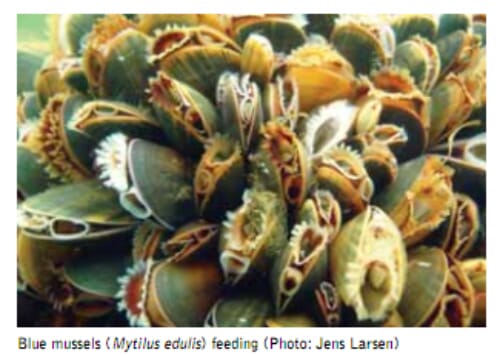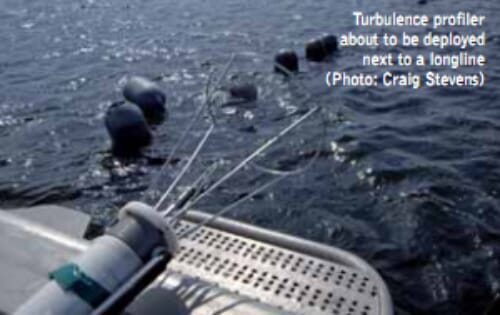They recently returned from a high-profile collaborative field experiment in Limfjorden Jutland, where a three-year international project is underway to enhance mussel farming in Denmark. While a wild fishery has existed there since the 1940s, Denmark’s mussel aquaculture is a relatively new venture. Its expansion has been rapid in the last decade, when the Danish government began issuing farm licences for Limfjorden Jutland.
Total farmed production was nearly 3000 tonnes by 2009 and while that is only about 10 per cent of New Zealand’s output, Denmark is now the fourth-largest mussel producer in Europe and plays an important role in the local economy. The Danish industry grows blue mussels (Mytilus edulis), a species widely distributed in European waters from Russia to the Atlantic coast of southern France. Although blue mussels can live for up to 24 years, most cultured mussels are produced in less than two years. Despite its success, Denmark’s mussel aquaculture industry is currently facing significant issues which distinguish it from New Zealand’s own aquaculture development. It’s historically strong wild shell? shery is struggling because of economic and environmental pressures.
The centre of the industry - both wild and cultivated – is the largely landlocked Limfjorden, a complex series of basins connected to both the North Sea and the Kattegat, the strait between Denmark and Sweden. Because the area is surrounded by agricultural farming and the basins are relatively low-flushing, the Limfjorden Jutland is typically quite eutrophic, with low water quality and frequent algal blooms, due to excessive nutrients. To mitigate these effects, mussel farms are being used to soak up excess nutrients in the water. Being able to sell the mussels for feed or human consumption is a bonus.

To help boost the industry, an international team of scientists, funded by the Danish government’s Strategic Research Fund, is part of the way through a three-year project to make mussel farming more eficient, while at the same time ensuring ecologically sustainable production that complies with environmental management requirements. As a result of the project, sophisticated aquaculture approaches to harvesting mussel crops are evolving to complement and enhance the existing industry. The project team includes biologists, oceanographers, economists and computer modellers from Canada, the United States and Germany, as well as Denmark and New Zealand. They are based at the Danish Shellfish Centre, a dedicated research station in central Jutland.
Mussels are passive, so they cannot adjust their position (well, not quickly) to improve their feeding. Locating the crop requires knowledge and forethought to maximise feeding rates and minimise the accumulation of waste deposits. This might seem simply a matter of locating them in the fastest-flowing water. However, competing use of water space and the limited working depths mean the answer is not always that simple. The New Zealand team is providing expertise to the project team about how to observe and measure the currents moving through and around the farm.
The water stratification means flow can also move under and over the farm. With low flows and lots of stratification, the water around the mussels can be quickly stripped of food. The key to replenishment is knowing the degree of turbulent mixing that refreshes the water and food supply right near the mussels. Without this, models are just nice pictures. How will the Danish project help New Zealand aquaculture development? Stevens says the most important lesson learnt from the Danish project is that we need to embrace complexity. The Limfjorden Jutland is a micro-tidal system, and so flushing is mainly driven by large storms which are hard to predict. Measurements taken show the clear effects on the flow from farms surrounding the basin that is guiding the water flow in certain ways.

This farm-effect must be built into predictive models of the system to determine the best strategy to maximise feeding and minimise the accumulation of waste deposits. Another key factor is the water is quite strongly strati? ed compared to New Zealand coastal waters. This makes the shallow Limfjorden effectively much deeper in terms of how nutrients are passed around and so more comparable to New Zealand waters. A number of strategies are possible to maximise feeding and growth, given this strati? cation, based around understanding the seasonal variations in strati? cation and how the crop can be varied with this both in season and spatially throughout a farm.
Working on the Danish project has been quite challenging, says Stevens. It’s a very complex system and an ambitious research programme. but it brings substantial, high-level bene? ts to New Zealand. The Danish wind energy industry is a relevant example and has proven the benefits of building a knowledgebased sector around an industry and so corner the market internationally in terms of ideas and staying at the leading edge. If we can build on this with mussels at a national level, New Zealand stands to keep a hand on the tiller in terms of leading mussel aquaculture. We are world leaders in understanding how suspended culture effects and is affected by flow variability. This will become more and more important as aquaculture space is limited.
So while we are exporting our skills and knowledge it’s a two-way street. By working with top-level scientists in complementary science areas we bring home a range of ideas about how to improve our own approaches to understanding environmental influences on production, impacts and how to turn ideas into benefits for society. Also, using mussels to soak up excess nutrients is highly relevant to ideas about how to mitigate fish farm effects. Stevens says New Zealand’s involvement in this international project is part of a broad initiative to have a much more knowledge-based approach to working with, and using, our oceans and coastal waters.
The basic tools for quantifying transport and mixing seawater and the nutrients carried with it can be applied to a wide range of sectors, including energy supply, biosecurity, future climate forecasting and food production. The challenge is connecting the improvements in understanding how the ocean works to the particular needs of each sector.

